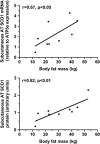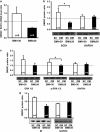Stearic acid content of abdominal adipose tissues in obese women
- PMID: 23154679
- PMCID: PMC3302147
- DOI: 10.1038/nutd.2011.19
Stearic acid content of abdominal adipose tissues in obese women
Abstract
Objective: Subcutaneous (SC) adipose tissue stearic acid (18:0) content and stearoyl-CoA desaturase-1 (SCD1)-mediated production of oleic acid (18:1) have been suggested to be altered in obesity. The objective of our study was to examine abdominal adipose tissue fatty acid content and SCD1 mRNA/protein level in women.
Subjects and methods: Fatty acid content was determined by capillary gas chromatography in SC and omental (OM) fat tissues from two subgroups of 10 women with either small or large OM adipocytes. Samples from 10 additional women were used to measure SCD1 mRNA and protein expression, total extracellular signal-regulated kinase 1/2 (ERK1/2) and phosphorylated ERK1/2 protein as well as insulin receptor (IR) expression levels.
Results: OM fat 18:0 content was significantly lower in women with large OM adipocytes compared with women who had similar adiposity, but small OM adipocytes (2.37±0.45 vs 2.75±0.30 mg per 100 g adipose tissue, respectively, P0.05). OM fat 18:0 content was negatively related to the visceral adipose tissue area (r=-0.44, P=0.05) and serum triglyceride levels (r=-0.56, P<0.05), while SC fat 18:0 content was negatively correlated with total body fat mass (BFM) (r=-0.48, P<0.05) and fasting insulin concentration (r=-0.73, P<0.005). SC adipose tissue desaturation index (18:1/18:0), SCD1 expression and protein levels were positively correlated with BFM. Moreover, obese women were characterized by a reduced OM/SC ratio of SCD1 mRNA and protein levels. A similar pattern was observed for ERK1/2 and IR expression.
Conclusion: The presence of large adipocytes and increased adipose mass in a given fat compartment is related to reduced 18:0 content and increased desaturation index in women, independently of dietary fat intake. The depot-specific difference in ERK1/2 expression and activation, as well as in SCD1 and IR expression in obese women is consistent with the hypothesis that they may predominantly develop SC fat, which could in turn help protect from metabolic disorders.
Figures



Similar articles
-
Omental adipose tissue type 1 11 beta-hydroxysteroid dehydrogenase oxoreductase activity, body fat distribution, and metabolic alterations in women.J Clin Endocrinol Metab. 2009 Sep;94(9):3550-7. doi: 10.1210/jc.2008-2011. Epub 2009 Jun 30. J Clin Endocrinol Metab. 2009. PMID: 19567539
-
Adipose tissue diacylglycerol acyltransferase activity and blood lipoprotein triglyceride enrichment in women with abdominal obesity.Atherosclerosis. 2014 Mar;233(1):172-7. doi: 10.1016/j.atherosclerosis.2013.12.041. Epub 2014 Jan 8. Atherosclerosis. 2014. PMID: 24529140
-
Abdominal subcutaneous and omental adipocyte morphology and its relation to gene expression, lipolysis and adipocytokine levels in women.Metabolism. 2014 Mar;63(3):372-81. doi: 10.1016/j.metabol.2013.11.007. Epub 2013 Nov 21. Metabolism. 2014. PMID: 24369916
-
Expression and activity of 20alpha-hydroxysteroid dehydrogenase (AKR1C1) in abdominal subcutaneous and omental adipose tissue in women.J Clin Endocrinol Metab. 2005 Jan;90(1):264-70. doi: 10.1210/jc.2004-0583. Epub 2004 Oct 19. J Clin Endocrinol Metab. 2005. PMID: 15494462
-
Visceral adiposity and inflammatory bowel disease.Int J Colorectal Dis. 2021 Nov;36(11):2305-2319. doi: 10.1007/s00384-021-03968-w. Epub 2021 Jun 9. Int J Colorectal Dis. 2021. PMID: 34104989 Review.
Cited by
-
TNF-α/Stearate Induced H3K9/18 Histone Acetylation Amplifies IL-6 Expression in 3T3-L1 Mouse Adipocytes.Int J Mol Sci. 2024 Jun 20;25(12):6776. doi: 10.3390/ijms25126776. Int J Mol Sci. 2024. PMID: 38928498 Free PMC article.
-
Maternal malnutrition and offspring sex determine juvenile obesity and metabolic disorders in a swine model of leptin resistance.PLoS One. 2013 Oct 24;8(10):e78424. doi: 10.1371/journal.pone.0078424. eCollection 2013. PLoS One. 2013. PMID: 24205230 Free PMC article.
-
Decreasing stearoyl-CoA desaturase-1 expression inhibits β-catenin signaling in breast cancer cells.Cancer Sci. 2013 Jan;104(1):36-42. doi: 10.1111/cas.12032. Epub 2012 Nov 9. Cancer Sci. 2013. PMID: 23013158 Free PMC article.
-
3D Adipose Tissue Culture Links the Organotypic Microenvironment to Improved Adipogenesis.Adv Sci (Weinh). 2021 Aug;8(16):e2100106. doi: 10.1002/advs.202100106. Epub 2021 Jun 24. Adv Sci (Weinh). 2021. PMID: 34165908 Free PMC article.
-
What role do fat cells play in pancreatic tissue?Mol Metab. 2019 Jul;25:1-10. doi: 10.1016/j.molmet.2019.05.001. Epub 2019 May 7. Mol Metab. 2019. PMID: 31113756 Free PMC article. Review.
References
-
- Despres JP, Lemieux I. Abdominal obesity and metabolic syndrome. Nature. 2006;444:881–887. - PubMed
-
- Yusuf S, Hawken S, Ounpuu S, Bautista L, Franzosi MG, Commerford P, et al. Obesity and the risk of myocardial infarction in 27,000 participants from 52 countries: a case-control study. Lancet. 2005;366:1640–1649. - PubMed
-
- Garaulet M, Hernandez-Morante JJ, Lujan J, Tebar FJ, Zamora S. Relationship between fat cell size and number and fatty acid composition in adipose tissue from different fat depots in overweight/obese humans. Int J Obes (Lond) 2006;30:899–905. - PubMed
-
- Roberts R, Hodson L, Dennis AL, Neville MJ, Humphreys SM, Harnden KE, et al. Markers of de novo lipogenesis in adipose tissue: associations with small adipocytes and insulin sensitivity in humans. Diabetologia. 2009;52:882–890. - PubMed
-
- Hodson L, Skeaff CM, Fielding BA. Fatty acid composition of adipose tissue and blood in humans and its use as a biomarker of dietary intake. Prog Lipid Res. 2008;47:348–380. - PubMed
LinkOut - more resources
Full Text Sources
Miscellaneous

